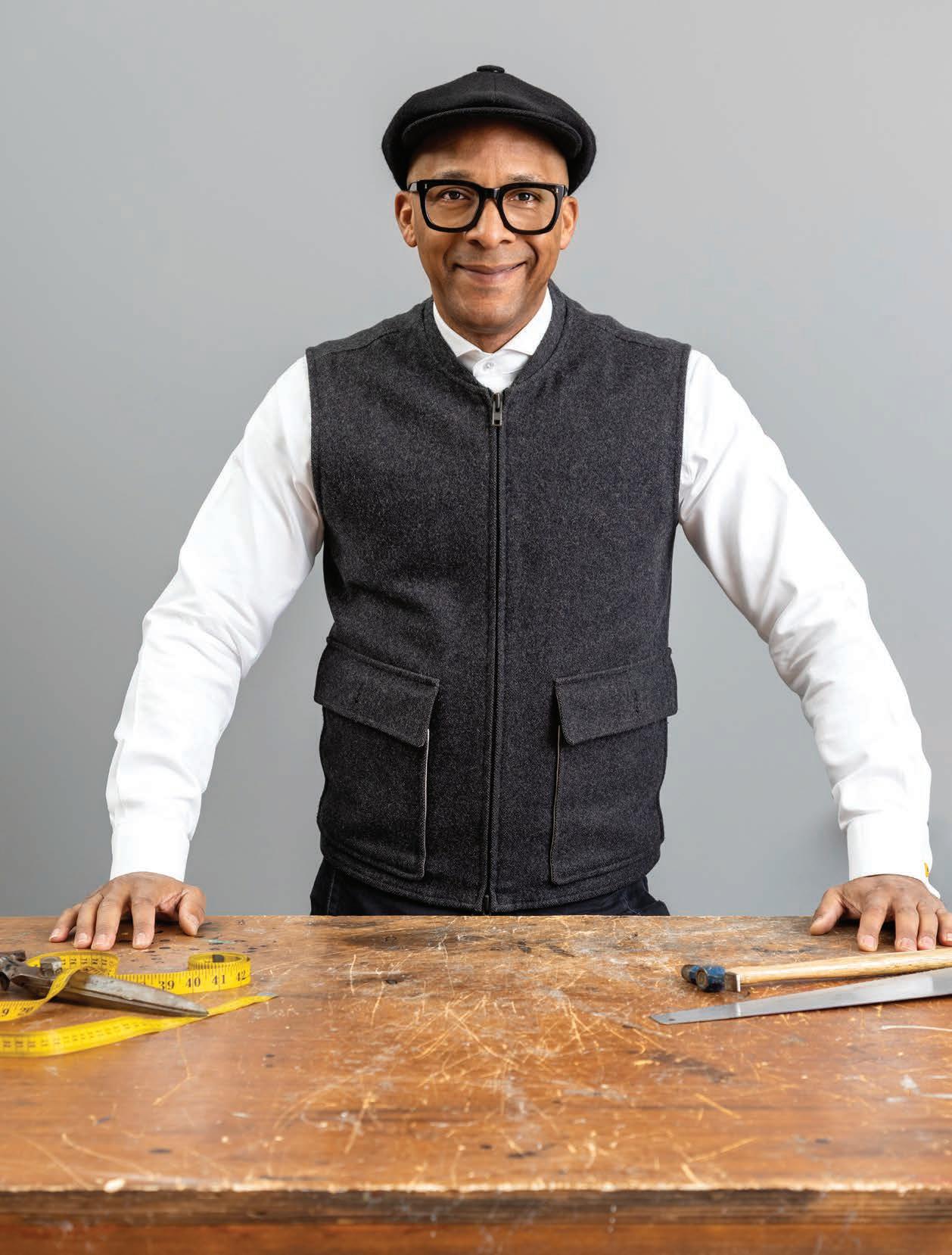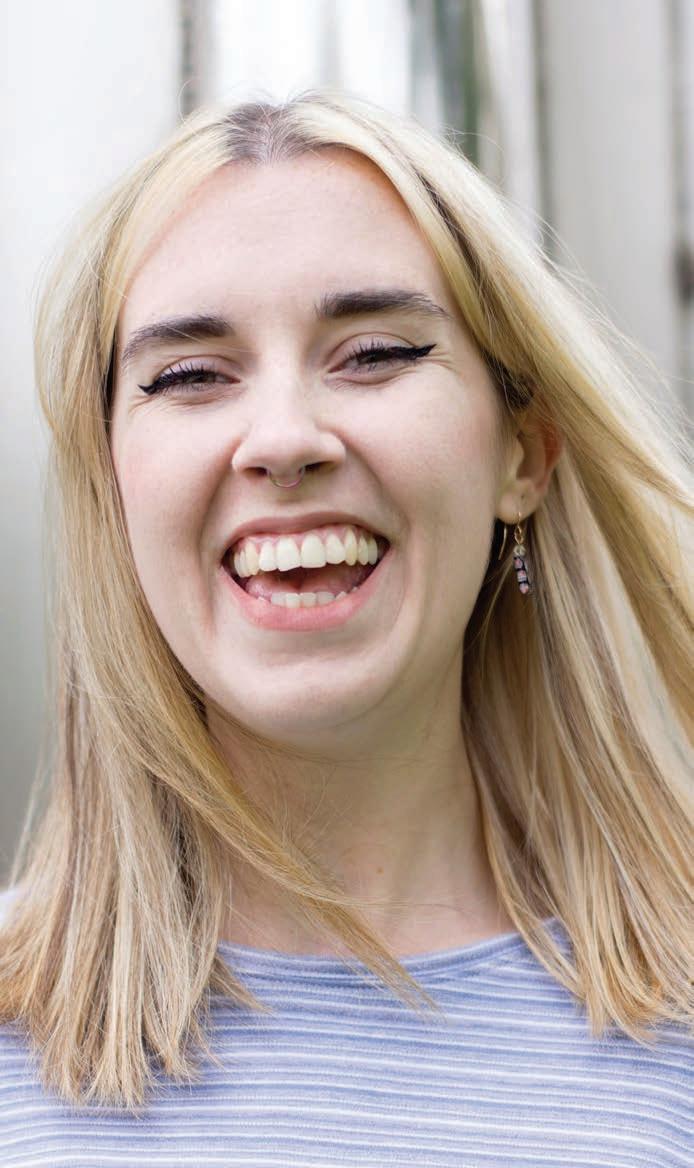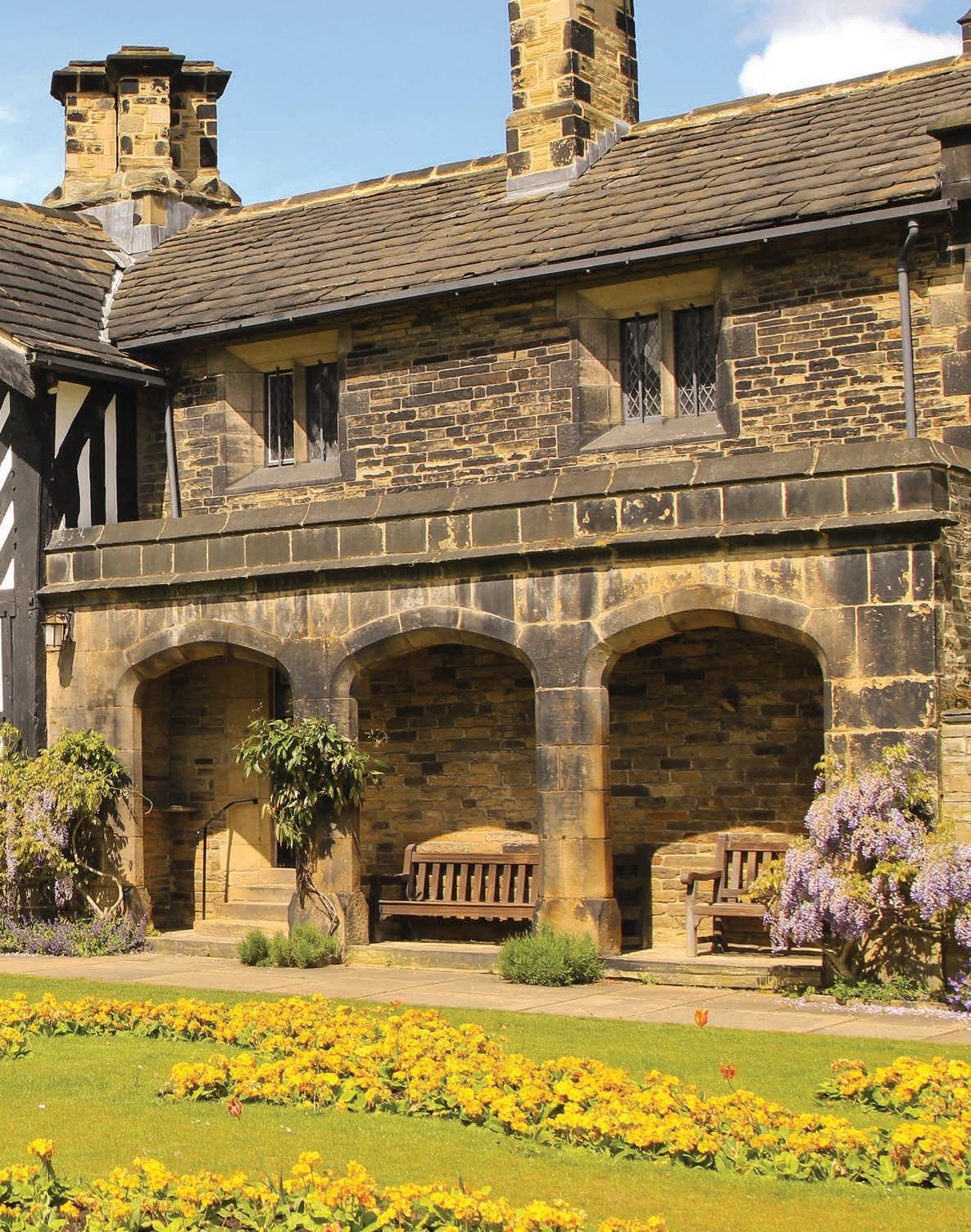
12 minute read
JAY BLADES
M A K E D O A N D MEND
The Repair Shop’s Jay Blades MBE on how the people of Yorkshire have helped inspire him to get the nation DIYing
By REBECCA PITCAIRN
Jay Blades has a bit of a soft spot for Yorkshire. It’s one of the reasons The Repair Shop front man chose the city for last year’s BBC2 spin-o show, Jay’s Yorkshire Workshop. “Yorkshire has a lot of history, but I think it’s the people that make it. There is a real warmth,” the 52-year-old tells me during a brief break in his hectic TV filming schedule. “When I’m in Yorkshire, I love it. It’s probably one of the only other places in the UK that I would live and that’s solely down to the people there.”
While The Repair Shop, which Shropshire-based Jay has presented since it began in 2017, sees members of the public bring in much-loved items for restoration, his Yorkshire workshop is all about creating something from scratch.
Filmed in Bradford’s Little Germany district, the feel-good show, which has run for just one series so far, sees members of the public nominate deserving local heroes from across Yorkshire to receive a bespoke, handmade piece of wooden furniture in recognition of the work they do for their community.
In one of the episodes an arbour is created for a care home in Doncaster to honour sta who moved in for 56 days during the first lockdown to look after residents. In another, a rocking horse is made for a Hull couple who have fostered 130 children. “It’s a really beautiful show,” says Jay. “There are some brilliant characters and the things that they have done for the community have gone way above and beyond. The thing I love about the Yorkshire show compared with The Repair Shop is that you’re making an item from scratch and there is only one of that thing in the whole world.”
Having had almost six years of success on The Repair Shop, which is filmed in the middle of the South Downs in Sussex and now watched by over seven million people, Jay felt it was important to give people in the north some representation.
“I wanted to celebrate the uncelebrated,” he says of his decision to base his workshop in Yorkshire. “There are places in the UK that we don’t celebrate enough and it’s important to hear a di erent type of voice. What tends to happen is we focus a lot on the south and there is some real talent and some real community in the north – especially Yorkshire.”
Another of the Yorkshire show’s USPs is that, alongside the three woodwork experts, there are six 'rookie' woodworkers
HE BASED HIS LATEST SERIES IN SHEFFIELD


from Bradford, Leeds and Huddersfield, who help make the items. “I wanted to find people who had done a bit already, knew their way around a workshop, but that had not necessarily done it with a camera in front of them,” he explains the process in finding his six apprentices. “I like to work with real people, real members of the community. I don’t want to work with anyone that’s too polished.”
Despite the north/south divide in terms of locality, what is similar about The Repair Shop and Jay’s Yorkshire Workshop is their ability to pull on the heart strings. Although
It’s a belief that’s also reflected in his latest book, DIY with Jay, which aims to teach even those with the worst DIY track record how to tackle household jobs. From fixing a dripping tap and choosing the right wall plugs to making new sofa covers or building your own BBQ, it’s a foolproof guide to doing it yourself, interspersed with tales of Jay’s own DIY escapades.
“I want people to understand that fixing stu is quite simple and everybody starts somewhere,” Jay says. “All of the experts that you see at The Repair Shop were all beginners at some point. No-one is born an expert. Some of my first attempts were rubbish, but once you achieve something, something as simple as putting up a shelf or even a picture frame and it isn’t wonky, you can walk past it and feel happy.”
And with the cost of living rising, fixing up the things we have got is a challenge that, according to Jay, we should all be taking on wholeheartedly. “We’re going to need to watch the pennies and that means doing it yourself,” he adds. “There’s been that make do and mend culture in the past and all I’m doing with this book is giving you an advantage so you can give it a go yourself and save yourself a couple of quid.”

Jay, who received an MBE for his services to craft in May this year, doesn’t believe one story is more heart-warming than another.
“When you’ve got someone helping people out with a furniture bank, you’ve got someone doing stu for veterans, you’ve got people helping in care homes and then you’ve got a young boy who saved his dad’s life, how could you say one is better than the other?” he says. “If you can, I guarantee that you don’t have a heart.”
Jay himself is no stranger to adversity. He has spoken openly about his struggles with mental health and dyslexia, which went undiagnosed as a child meaning he didn’t learn to properly read or write until just last year – a challenge he documented for the BBC documentary, Learning to Read at 51.
“Only one person knew on [The Repair Shop] set and that was Kirsten [Ramsay],” he admits. “She used to help me by telling me about the emails that came through from the producers because she knew I wouldn’t have read them.
“I did that documentary to inspire people,” he adds, “to show them that you can make a di erence even if you have a vulnerability, whether that’s reading or mental health.”
JAY HAS INSPIRED MANY INTO WORKSHOPS
DIY with Jay: How to Repair and Refresh Your Home is out now, published by Bluebird, RRP £20. All episodes of Jay’s Yorkshire Workshop and The Repair Shop are available to stream on BBC iPlayer








Get to know… ELEANOR MAY BLACKBURN
She eld actor and writer
By BETHAN ANDREWS
Q How long have you been acting for and when and where did your journey first begin?
A I’ve been acting since I was about four! I used to dress up constantly when I was little and I’d devise plays with my cousins and put them on for my mum and dad. I’d charge them to watch even though it was their house! When I was about 12, I joined a drama group with an agency attached, so I did a lot of supporting artist work on CBBC and BBC, before I went to SCALA in Leeds. At college, I studied acting.
Q You were studying drama at University in Falmouth when you had an accident. Can you tell us more about that and how it has shaped your life and career since?
A I was in my first term and it was 19 November 2015. I’d had a really long day at Uni and it was getting dark. There was a push bike coming down the hill, and I don’t think it was their fault, in fact, it was probably mine for being tired, but I stepped out in front of them and they hit me. I had a right-sided subdural hematoma which caused a stroke, and they rushed me to Truro Hospital before I was transferred to a specialist unit in Plymouth. My parents were called and asked how quickly they could get there and they were told they needed permission to operate and to get ready to say goodbye. I had to learn to eat, talk and walk again, but I got out of hospital on 16 January and went back to Uni the September following. I was still very much in recovery with speech therapy, occupational therapy, hydrotherapy and working on my concentration, but I didn’t want to give up. I rushed myself to get back into acting, but I’ve always been so stubborn and I wanted to prove everyone wrong – and I suppose I did.
Q Tell us about your own show that you wrote and toured with this year, Subdural Hematoma…
A I had a module at Uni called Show in a Bag and it was meant to be a piece that you could take anywhere and perform at any time. I was challenged by one of my tutors to make

BUNS AT BUNGALOW AND BEARS

something funny, as I usually fell back on drama and tragedy. I wondered if I could turn my accident into a comedy piece, so I wrote a bit of spoken word, performed it in class and people were really laughing. I extended that and turned it into a 15-minute piece and it got an amazing reaction that I could never have dreamed of and got the highest mark at Uni. The Crucible in She eld were doing an open submissions programme so I turned it into a 60-minute piece, because I had the time in lockdown to do it, and it narrowly missed out at the end of the process, but I decided to take it to Manchester Fringe. It’s made up of my mum’s diary entries that she kept at the time, mixed with me responding in spoken word, with verbatim, physical theatre and testimonials from other brain injury survivors. I applied for Arts Council Funding and won, which meant I could take it on tour in March of this year.

Q You’re born and bred in She eld. Would you say it’s somewhere that’s very supportive to those in the performing arts?
A Oh, I’d definitely say so. I’m from a place called Chapeltown and the She eld theatre scene is just fantastic – it’s really supported me. I had a short residency with She eld
SHE LOVES THE PEAKS
ELEANOR ON STAGE
SHEFFIELD THEATRES HAVE BEEN SUPPORTIVE Theatres last year and I’ve been part of their script reading team and part of their Young Company for 2021 and 2022.

Q What are your favourite parts of the city?
A I love how green it is, it’s so beautiful. I think it’s such a hub for Yorkshire, too. You go into the town centre and you’re just surrounded by all of these amazing theatres. I definitely look at it from an artist’s perspective now and I think the theatres are just incredible, they are so beautiful and real hidden gems of the city. It’s a really friendly city too, it makes you feel so at home.
Q Where do you like to hang out in She eld?
A The Washington is my favourite pub and I absolutely adore it there. I also love going out to eat at Bungalows and Bears and Temple of Fun. I’m coeliac and vegetarian and it has all the gluten free options, which is always really nice.
Q Do you have any favourite places to escape to in Yorkshire?
A I really love York. I think it’s such a beautiful city. But, I think it would have to be The Peaks – they are just so, so nice. I’ve started going wild swimming and I went to so many amazing spots in the summer. There are also so many amazing hilltops for watching the sunset on too, it’s a really special place. I wrote a long piece of spoken word for BBC Uploads about the north called Mardy Bum and I think it says most of what I’m trying to say. She eld and the north is such an inspiring place to be. There are so many music legends from here and it’s definitely iconic for the arts.








THE STORY BEHIND...
SHIBDEN HALL
Shibden Hall dates back to 1420 and o ers visitors a fascinating journey through the lives of the people who lived and worked here, including the noted diarist Anne Lister (1791-1840).
Shibden Hall’s architecture is a mix of styles reflecting its interesting and varied history. The adjacent 17th century aisled barn and workshops house a carriage collection and displays relating to di erent crafts, including a blacksmiths, coopers, wheelwrights and saddlers.
The Hall is surrounded by the beautifully restored gardens and estate that forms Shibden Park. There are a range of features and attractions, including a cafe and visitor facilities, miniature railway, boating lake, walking trails, play area, orienteering course and woodland in which to roam.
Shibden Hall is the focus of the BBC drama series written by Sally Wainwright, 'Gentleman Jack', exploring the life of Anne Lister and those who lived in the Hall and Estate. The first series aired in the UK on 19 May 2019.
Now to mark its 600th birthday, Bankfield Museum is hosting a special exhibition that will celebrate Shibden Hall and its many inhabitants. It features stunning images by renowned artists such as John Horner, as well as objects from throughout the hall’s history, including a personal letter from Anne Lister.

museums.calderdale.gov.uk











